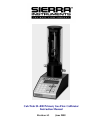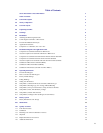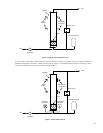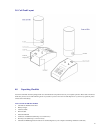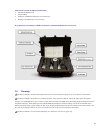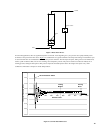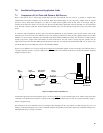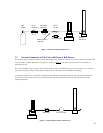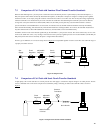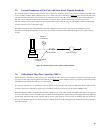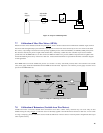5
1.0 General Description
The Sierra Cal=Trak SL-800 is the most accurate commercially available gas flow calibrator. Using near-frictionless piston technology, it
combines the accuracy of a primary standard with unequaled speed and convenience.
The Cal=Trak consists of two primary sections. The base houses the main computer, time base and barometric pressure sensors while the
flow cell performs the actual physical measurements using a precision-machined graphite composite piston and borosilicate glass tube. The
flow cell also contains the integrated temperature sensor. The base has 9-pin connector and two guide pins on its upper surface into which
the interchangeable flow cells are installed.
Mass (Standardized) or volumetric flow readings are obtained with the push of a button. The Cal=Trak can be set to take flow readings
manually, one reading at a time, or automatically, in the auto-read mode. The Cal=Trak can be programmed for up to 100 readings in an
averaging sequence. It can be used to measure gas flow rates from most positive pressure sources or under vacuum. Please contact Sierra
Instruments for special precautions before using your Cal=Trak under vacuum.
The Cal=Trak includes a convenient LCD user interface in the base unit. In addition, an RS-232 port for computer interface capability is
provided. An Application program for downloading data from Cal=Trak into Microsoft Excel is on the included CD-ROM. See Appendix
C: Cal=Trak Software Instructions for Data Downloading at the end of this Manual.
2.0 Theory of Operation
The Sierra Cal=Trak SL-800 is a true primary gas standard. The time required for the graphite composite piston to traverse a known
distance through the flow cylinder is precisely measured and an internal computer calculates the flow. The volumetric accuracy of the
instrument is built into its dimensional characteristics. Standardization of the gas flow readings to obtain mass flow is achieved with
precisely calibrated temperature and pressure sensors.
Piston provers like the Cal=Trak are characterized by the most basic of quantities: length and time. As flow is necessarily a derived unit, a
dimensionally characterized system would be as close as possible to direct traceability from national dimensional standards.
An idealized piston prover would consist of a mass-less, friction-less, leakproof, shape-invariant and impermeable piston inserted within the
flow stream and enclosed by a perfect cylinder. The time that the piston takes to move a known distance (which implies a known volume)
then yields the volumetric flow Q as:
Q = V / T =
π
r
2
h / T
Where:
• V is measured volume
• T = measurement time
• r = radius of cylinder
• h = length (height) of measurement path
Such a device would be as accurate as its physical dimensions and its clock, with almost insignificant drift mechanisms. Although such
idealized devices do not exist, we believe the Cal=Trak offers close to ideal performance (Figure 1).
The Cal=Trak clearance-sealed prover uses a piston and cylinder fitted so closely that the viscosity of the gas under test results in a leakage
small enough to be insignificant. For reasonable leakage rates, such a gap must be approximately 10 microns. As a practical matter, the
piston and cylinder are made of graphite and borosilicate glass because of their low, matched temperature coefficients of expansion and low
friction.



